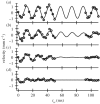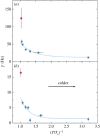Quantum phase slips: from condensed matter to ultracold quantum gases
- PMID: 29084890
- PMCID: PMC5665781
- DOI: 10.1098/rsta.2016.0425
Quantum phase slips: from condensed matter to ultracold quantum gases
Abstract
Quantum phase slips (QPS) are the primary excitations in one-dimensional superfluids and superconductors at low temperatures. They have been well characterized in most condensed-matter systems, and signatures of their existence have been recently observed in superfluids based on quantum gases too. In this review, we briefly summarize the main results obtained on the investigation of phase slips from superconductors to quantum gases. In particular, we focus our attention on recent experimental results of the dissipation in one-dimensional Bose superfluids flowing along a shallow periodic potential, which show signatures of QPS.This article is part of the themed issue 'Breakdown of ergodicity in quantum systems: from solids to synthetic matter'.
Keywords: dissipation; quantum phase slips; superfluids; transport.
© 2017 The Author(s).
Conflict of interest statement
The authors declare that they have no competing interests.
Figures






References
-
- Little WA. 1967. Decay of persistent currents in small superconductors. Phys. Rev. 156, 396–403. (10.1103/PhysRev.156.396) - DOI
-
- Landau LD, Ginzburg VL. 1950. On the theory of superconductivity. Zh. Eksp. Teor. Fiz. 20, 1064–1082.
-
- Langer JS, Ambegaokar V. 1967. Intrinsic resistive transition in narrow superconducting channels. Phys. Rev. 164, 498–510. (10.1103/PhysRev.164.498) - DOI
-
- McCumber D, Halperin B. 1970. Time scale of intrinsic resistive fluctuations in thin superconducting wires. Phys. Rev. B 1, 1054–1070. (10.1103/PhysRevB.1.1054) - DOI
Publication types
LinkOut - more resources
Full Text Sources
Other Literature Sources

